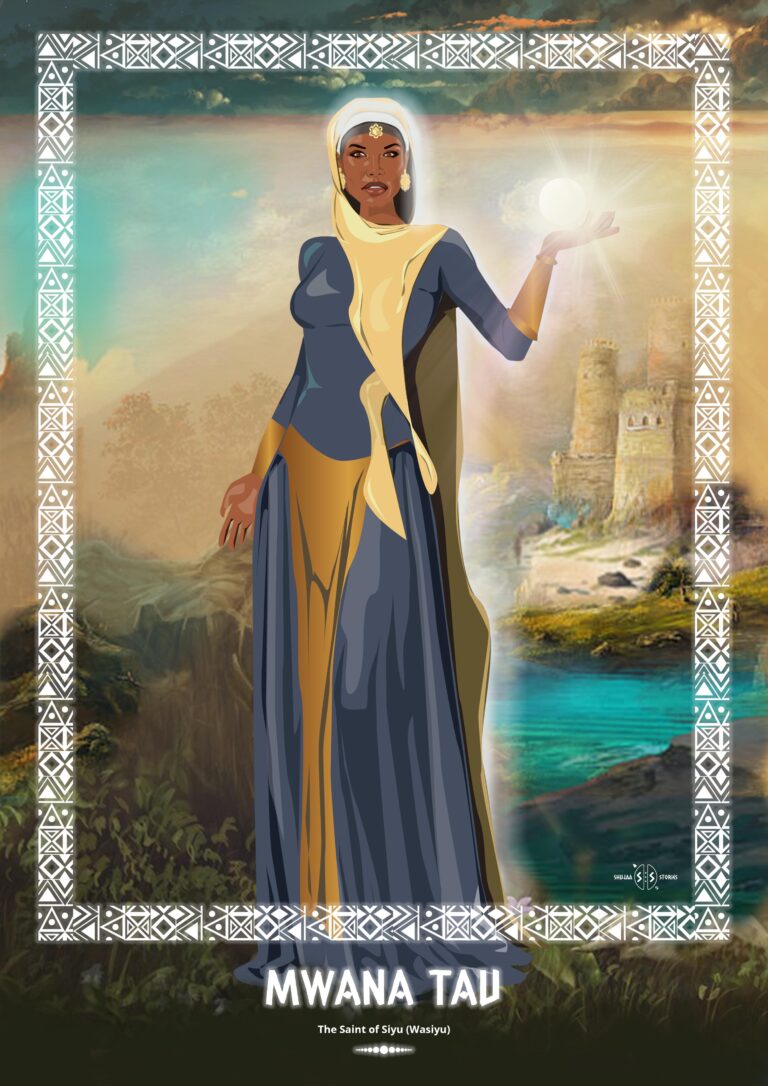The Saint of Siyu (Swahili)
Long ago, in the coastal town of Siyu, there lived a woman named Mwana Tau. She was a beloved figure known for her exceptional piety and a special gift
bestowed upon her by God; the ability to perform miracles. Her reputation spread far and wide, and people from near and far sought solace and inspiration from her remarkable presence.
Mwana Tau died 1860 AD. Her passing left a void in the hearts of many, but her spirit remained alive in the hearts of those who believed in her remarkable abilities. She was laid to rest in Siyu, a tranquil corner of Pate island.
People were drawn to Mwana Tau’s tomb, a place where they could connect with her divine essence. They visited her final resting place to seek blessings and offer prayers. This act, known as “weka nadhiri,” was a testament to their unwavering faith in her powers.
Throughout her life, Mwana Tau displayed immense wisdom and devotion. She was a learned scholar, revered for her deep understanding of religious teachings. Her parents, both scholars themselves, instilled in her a love for knowledge from a young age. Her father, a respected Sharif, and her mother, a Famawi, guided her along the path of enlightenment.
Within the walls of her humble abode, Mwana Tau shared her wisdom with eager students. One of her notable disciples was her niece, Fatma Bint Sayyid Muhdhar, affectionately known as Mwana Mgoli. Mwana Mgoli, meaning “greatly petted,” inherited Mwana Tau’s dedication to learning and teaching.
One tale that remains etched in the annals of history is the story of Mwana Tau’s miraculous intervention during a treacherous storm at sea. The ocean was rough and the dhow rocked violently. The storm was making things very hard for the crew on board. As if things couldn’t get any worse, the patch (known as hasho) on the dhow’s side, fell and disappeared into the ocean. Water began to enter and fill the dhow.
“We’re going to die!” someone shouted.
“We are finished!” another concurred.
“No, we shall not die. At least not today!” a wise crew member said, “Let us ask Mwana Tau for her help.”
The rest of the crew heeded his words and together, they cried out to Mwana Tau. Suddenly, water stopped filling the dhow. The crew was overjoyed and they quickly made their way back to shore. They dragged the dhow to land and began inspecting it. To their utmost surprise, they found Mwana Tau’s shoe in the patch’s place.
As witnesses marvelled at the dhow’s intact condition, they discovered the shoe, serving as an unexpected blockade that had sealed the breach. This miraculous event was recounted by Sayyid Abdalla Saggaf, a respected scholar and madrasa teacher in Siyu, ensuring that the tale would be passed down through generations.
Mwana Tau’s karama; her extraordinary gift, touched the lives of many,reinforcing the faith and devotion of those who witnessed her miracles. Her legacy, intertwined with the teachings of Mwana Mgoli and the shared wisdom of Siyu, continues.
Bonus information
In Lamu, there are no vehicles and the only means of transport are donkeys, boats and motorbikes and this is because of its narrow streets. However, this has helped reduce the excessive amount of carbon(iv)oxide emitted by moving vehicles thus reducing the harmful effects of greenhouse gases which are causing climate change.

